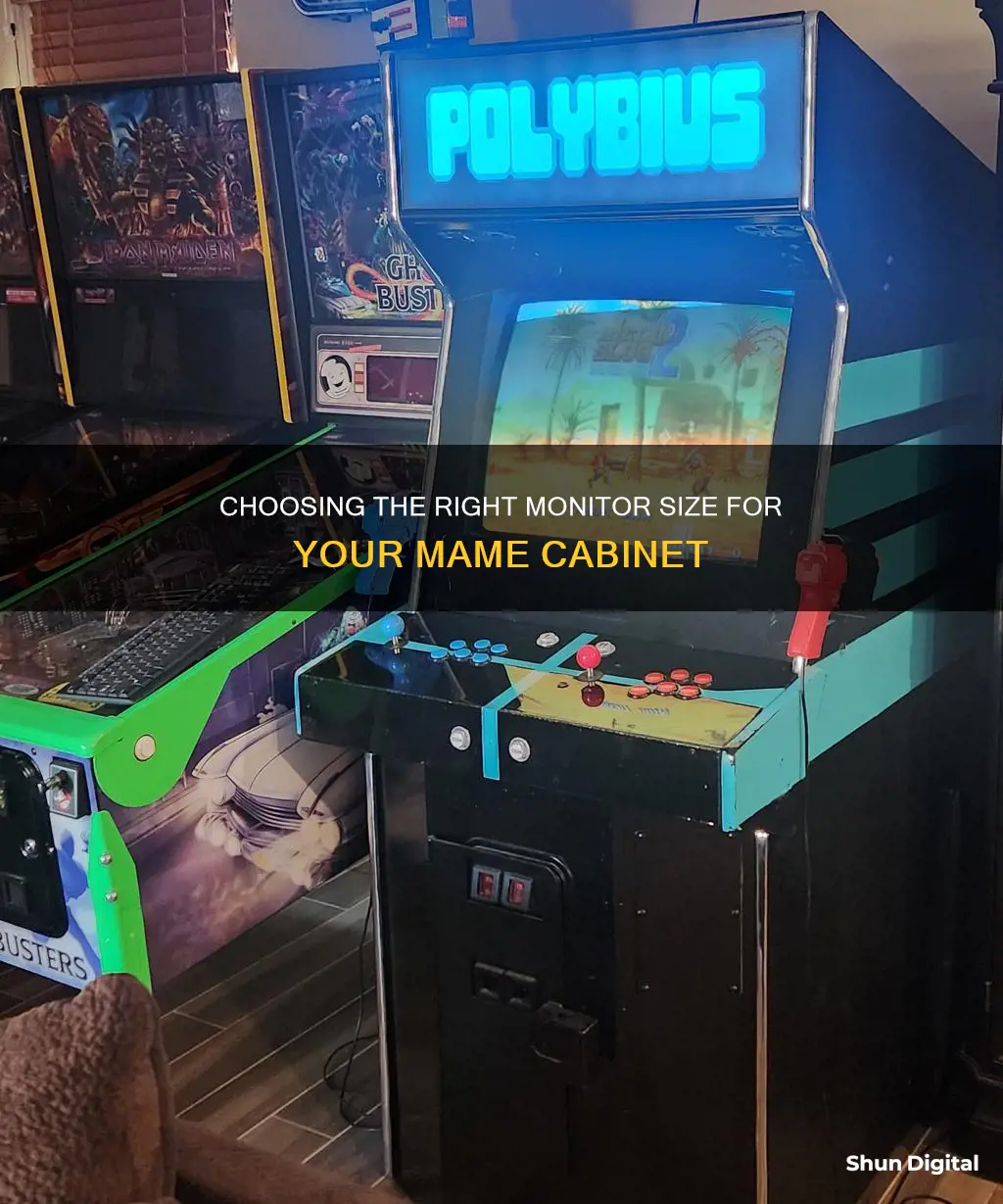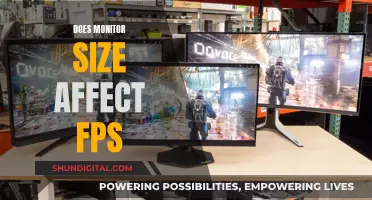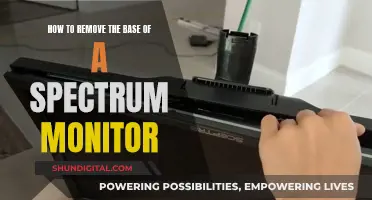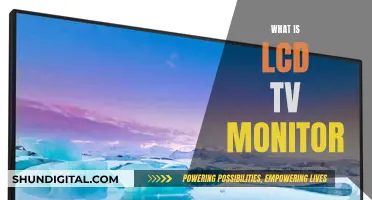
When it comes to choosing a monitor size for MAME, there are a few factors to consider. Firstly, it's important to note that MAME (Multiple Arcade Machine Emulator) is used to emulate arcade games, and as such, the monitor size and aspect ratio can impact the gaming experience. While some gamers prefer the traditional arcade look with larger CRT monitors, others opt for more modern LCD screens that offer clearer displays and high resolutions. The most commonly recommended monitor sizes for MAME range from 19 inches to 32 inches, with some gamers even suggesting custom-sized LCDs from companies like Litemax. Ultimately, the choice of monitor size depends on the user's preferences, the available space, and the desired gaming experience.
| Characteristics | Values |
|---|---|
| Monitor Size | 19", 20", 21", 24", 26", 27", 28", 32" |
| Aspect Ratio | 4:3, 5:4, 16:9, 16:10 |
| Resolution | 1280 x 1024, 1600x1200, 1800x1400, 1920 x 1080, 1536 x 2048 |
| Monitor Type | LCD, LED, CRT |
| Brands | Dell, Samsung, Viewsonic, Acer, RetroArcade.us, UNICO, Litemax |
What You'll Learn

19-inch LED monitors for MAME and Jamma
If you're looking for a 19-inch LED monitor for your MAME and Jamma arcade projects, there are a few options available. Firstly, there is the RetroArcade.us 19-inch Arcade Game LED Monitor, which is designed specifically for gaming and offers a high-quality viewing experience with vivid colours and a wide viewing angle. This monitor has a VGA input and supports EGA and VGA resolutions from 640 x 480 up to 1280 x 1024. It has a contrast ratio of 450:1 and a brightness of 250 cd/m2, with a pixel response time of 16 ms. The weight of the monitor is 13.2 lbs, and it comes with a power cord and VGA cable.
Another option is to consider a used 19-inch Arcade Game LED Monitor offered by Holland Computers, which is compatible with Jamma, MAME, and Cocktail game cabinets. This monitor also has a VGA input and supports EGA and VGA resolutions. While specific details about this monitor's specifications are not available, it is a more affordable option and may be suitable for those on a tighter budget.
When choosing a monitor for your MAME and Jamma projects, it is important to consider factors such as compatibility, display quality, and ease of installation. Additionally, some monitors may require professional electronic experience for installation, so it is essential to review the product specifications and instructions carefully.
It is worth noting that some customers who purchased the RetroArcade.us monitor have reported issues with the viewing angles, despite the product description claiming they are excellent. There have also been reports of difficulties centring the screen and issues with the monitor becoming defective after a period of frequent use. Therefore, thorough research and consideration of customer reviews are recommended before making a purchase.
Large Monitors: A Nausea Trigger?
You may want to see also

32-inch LED monitors for MAME and Jamma
When it comes to choosing a monitor for your MAME (Multiple Arcade Machine Emulator) or Jamma arcade setup, there are a few things to consider, such as size, weight, connectivity, and compatibility. While some purists prefer the "genuine" arcade look of a CRT monitor, others opt for the clarity, weight advantages, and ease of mounting that come with an LED monitor.
If you're in the market for a 32-inch LED monitor for your MAME or Jamma arcade cabinet, there are a few options available. One such option is the RetroArcade.us 32-inch Arcade Game LED Monitor, which can be found on Amazon and Walmart. This monitor offers a 1920 x 1080 resolution, with one VGA (15-pin D-Sub) and two HDMI inputs for connectivity. It has a contrast ratio of 5000:1, a brightness of 450 cd/m2, and a pixel response time of 16 ms. The package includes an AC power cord, a VGA cable, and mounting brackets, making it ready to use with Jamma and MAME boards.
Another option for a 32-inch LED monitor is the UNICO 26-inch Arcade Monitor, which can accommodate a screen size of up to 32 inches. This monitor offers a 4:3 ratio LCD screen, making it suitable for HDMI/VGA/CGA/EGA arcade machines. It is worth noting that this option has a smaller screen size than the previous one, but it can still fit a 32-inch screen in your arcade cabinet.
When choosing a monitor, it is important to consider the resolution and connectivity options that best suit your arcade setup. Additionally, pay attention to the warranty and return policies offered by the seller, as these may vary among different retailers.
While the 32-inch LED monitor options for MAME and Jamma may be limited, the RetroArcade.us monitor specifically designed for these setups seems to be a popular choice among arcade enthusiasts. It is always a good idea to read reviews and do your research before making a purchase decision.
Expanding Your View: Increasing Monitor Page Size to Maximize Your Display
You may want to see also

4:3 LCD monitors for MAME
If you're looking for a 4:3 LCD monitor for your MAME cabinet, you have a few options, though they may be harder to find and more expensive than 16:9 monitors.
Used 4:3 LCD Monitors
One option is to look for used 4:3 LCD monitors. You can often find these on eBay, Craigslist, or other second-hand markets. Keep in mind that older LCD monitors may have slower response rates, which can impact gaming performance.
Some specific models to look for include:
- Dell 2003FP: Clear and high-res, but may be hard to find as it's an older model.
- Dell 2007 FP: True 4:3 with a resolution of 1600x1200. Can often be found second-hand for a reasonable price.
- Samsung Syncmaster 213t: A great option that can be found for around $100.
- Viewsonic VP2130b: Performance is similar to the Samsung 214t.
- Samsung 214t: This model has double the contrast (1000:1) and triple the response time (8ms) of the 213t, but it may be harder to find.
- NEC MultiSync LCD2190UXp: A 21" 4:3 LCD monitor that has been used in a MAME cabinet before.
Newer 4:3 LCD Monitors
If you're looking for a newer 4:3 LCD monitor, there are a few options, but they tend to be more expensive.
- Benq 19" BL902TMF: A 5:4 monitor that is cheaper and closer in proportion to 4:3 than a 16:9 monitor.
- Litemax: A company that makes custom-size LCDs, but they have a minimum order and are quite pricey.
Other Options
If you can't find a 4:3 LCD monitor that fits your needs or budget, there are a few other options to consider:
- Use a 16:9 or 16:10 LCD monitor and add bezel art to the sides. Look for a monitor with a resolution of at least 1280x1024 to ensure your games look sharp.
- Mount a larger 16:9 or 16:10 monitor vertically. This will give you more height, but may not be the best use of screen space, especially for vertical games.
- Get in touch with Chinese companies that make custom-size LCDs by cutting them in a clean room and resealing the edges. This option is risky and expensive, but may be worth it if you're willing to take the plunge.
Monitoring Facetime Usage: A Guide for Parents
You may want to see also

16:9 LCD monitors for MAME
If you're building your own arcade cabinet, you'll need to consider the type of monitor you want to use. While some purists prefer original Arcade CRT monitors, others are more pragmatic and opt for LCD monitors, which are lighter, easier to mount, and can display modern games with high resolutions.
When it comes to 16:9 LCD monitors for MAME, there are a few options to consider. One user on Scott Hanselman's blog chose a Dell 2003FP LCD Monitor for their arcade cabinet, citing its clarity and high resolution. They also mention the option of using a 24" 16:9 LCD monitor with a bezel, or frame, to crop the sides and achieve the desired aspect ratio.
In the comments section of a Reddit post, users discuss their choices for LCD monitors in their arcade cabinets. One user recommends a 27" 16:9 monitor, citing that it offers the same height as a 4:3 monitor and the sides can be filled with bezel art. Another user suggests mounting a larger 16:9 monitor vertically to avoid the need for bezel art, but acknowledges that this setup may not be ideal for all cabinet designs.
Other users in the same thread mention specific 16:9 LCD monitors they have used successfully in their arcade cabinets. One user recommends the TCL 32” 1080p screen, while another user suggests the LG 32GK850G, a 165Hz g-sync WQHD display, for its excellent black levels.
Additionally, some users recommend using GLSL shaders in MAME to simulate the look of a CRT monitor on an LCD display. This can enhance the visual experience and make games appear more authentic.
When choosing an LCD monitor for your MAME arcade cabinet, it's important to consider the size of your cabinet, the desired aspect ratio, and whether you want to use bezel art or other adjustments to achieve the desired display format.
Dismantling Your ASUS 24" Monitor: Step-by-Step Guide
You may want to see also

CRT monitors for MAME
CRT monitors are the preferred choice for those seeking an authentic arcade experience when playing MAME (Multiple Arcade Machine Emulator). While modern LCD monitors offer high resolutions and lightweight designs, CRT monitors provide the "genuine" arcade look and feel.
When selecting a CRT monitor for MAME, there are several factors to consider. Firstly, size matters. A larger monitor, such as the Wells Gardener 27" Flat Screen Arcade CRT Monitor, offers an immersive experience but comes with challenges related to weight, mounting, and safety. Smaller CRT monitors, such as the 19-inch options available from brands like RetroArcade.us, provide a more compact solution.
Another consideration is the resolution and dot pitch of the CRT monitor. Arcade games typically use lower resolutions, such as 640x480 or 800x600, so ensure your CRT monitor can support these settings. Additionally, computer CRTs often have a finer dot pitch than arcade monitors, so pairing a lower resolution with a MAME scanline filter can enhance the arcade experience.
It's worth noting that CRT monitors designed for arcade use, such as the Wells Gardner and Betson models, may include features like multi-sync support and VGA connectivity, making them more versatile for use with modern hardware.
When building a MAME cabinet, it's essential to consider the mounting options for your CRT monitor. Most older arcade cabinets didn't mount the monitor at a vertical angle; instead, they were positioned nearer the horizontal to match the player's downward viewing angle. The standard VESA mount found on many LCD monitors can simplify the installation process.
Lastly, weight is a significant factor when choosing a CRT monitor for MAME. CRTs are notoriously heavy, and larger models can weigh between 80-95 lbs. Ensure your cabinet or setup can safely support the weight of the CRT monitor you select.
In summary, when choosing a CRT monitor for MAME, consider the size, resolution, mounting options, and weight. While larger CRTs offer an authentic arcade experience, smaller models provide more flexibility and are easier to transport. By pairing the right CRT monitor with the appropriate settings and filters, you can achieve the classic arcade look and feel that many enthusiasts seek.
Monitor Size Impact on FPS: Does Bigger Mean Better?
You may want to see also
Frequently asked questions
There is no standard size for MAME monitors. Monitor sizes for MAME range from 19 inches to 32 inches.
The best monitor size for MAME depends on the user's preferences and the size of their cabinet. Some users prefer larger monitors for a more immersive experience, while others prefer smaller monitors that fit more easily into a compact cabinet.
Recommended monitors for MAME include the Dell 2003FP LCD Monitor, the Wells Gardener 27" Flat Screen Arcade CRT Monitor, the Samsung Syncmaster 213t, and the ViewSonic VX2835wm.







